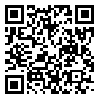Volume 12, Issue 2 (9-2019)
ijhe 2019, 12(2): 185-192 |
Back to browse issues page
Download citation:
BibTeX | RIS | EndNote | Medlars | ProCite | Reference Manager | RefWorks
Send citation to:



BibTeX | RIS | EndNote | Medlars | ProCite | Reference Manager | RefWorks
Send citation to:
Jonidi Jafari A, Ghorbannezhad F, Rastegar A. Estimation excess risk cancer due to natural gamma radiation exposure in outdoor areas for residents of Dargaz city in 2016. ijhe 2019; 12 (2) :185-192
URL: http://ijhe.tums.ac.ir/article-1-6064-en.html
URL: http://ijhe.tums.ac.ir/article-1-6064-en.html
1- Department of Environmental Health Engineering, School of Public Health, Iran University of Medical Sciences, Tehran, Iran AND Research Center for Environmental Health Technology, Iran University of Medical Sciences, Tehran, Iran
2- Student Research Committee, Sabzevar University of Medical Sciences, Sabzevar, Iran
3- Department of Environmental Health Engineering, School of Public Health, Iran University of Medical Sciences, Tehran, Iran AND Student Research Committee, Sabzevar University of Medical Sciences, Sabzevar, Iran ,rastegar.89@gmail.com
2- Student Research Committee, Sabzevar University of Medical Sciences, Sabzevar, Iran
3- Department of Environmental Health Engineering, School of Public Health, Iran University of Medical Sciences, Tehran, Iran AND Student Research Committee, Sabzevar University of Medical Sciences, Sabzevar, Iran ,
Abstract: (2426 Views)
Background and Objective: Humans are always exposed to ionizing radiation that could potentially have harmful effects. The aim of this study was to evaluate the background gamma dose rate, the estimated annual effective dose, and the excess cancer risk assessment in Dargaz.
Materials and Methods: This study was a cross sectional study which was conducted in January- March and July – September 2016. In this study, 5 stations (4 in the main geographical directions and 1 in the center city) were selected based on the map of the city to determine the dose rate of background gamma radiation in outdoor areas. A dosimeter was used (Geiger Müller detector STEP OD-02 with sensitivity of 0-2000 mSv/h) to measure gamma rays. The device was designed to monitore X-rays, gamma rays and beta rays.
Results: The results showed that the maximum and minimum mean values of background gamma dose rate were 147±12 nSv/h and 113±11 nSv/h in the center and west-direction of the city, respectively. The annual effective dose for Dargaz residents in outdoor was determined to be 0/15 mSv/yr, and the amount of excess lifetime cancer risk was estimated as 0.6×10-3.
Conclusion: The results indicated that there are significant differences between the rates dose in the center and other parts of the city (p≤0.05).
Materials and Methods: This study was a cross sectional study which was conducted in January- March and July – September 2016. In this study, 5 stations (4 in the main geographical directions and 1 in the center city) were selected based on the map of the city to determine the dose rate of background gamma radiation in outdoor areas. A dosimeter was used (Geiger Müller detector STEP OD-02 with sensitivity of 0-2000 mSv/h) to measure gamma rays. The device was designed to monitore X-rays, gamma rays and beta rays.
Results: The results showed that the maximum and minimum mean values of background gamma dose rate were 147±12 nSv/h and 113±11 nSv/h in the center and west-direction of the city, respectively. The annual effective dose for Dargaz residents in outdoor was determined to be 0/15 mSv/yr, and the amount of excess lifetime cancer risk was estimated as 0.6×10-3.
Conclusion: The results indicated that there are significant differences between the rates dose in the center and other parts of the city (p≤0.05).
Type of Study: Research |
Subject:
General
Received: 2018/04/21 | Accepted: 2019/06/12 | Published: 2019/09/4
Received: 2018/04/21 | Accepted: 2019/06/12 | Published: 2019/09/4
Send email to the article author
| Rights and Permissions | |
 |
This work is licensed under a Creative Commons Attribution-NonCommercial 4.0 International License. |





